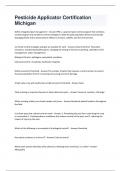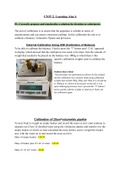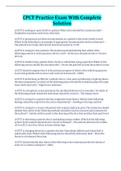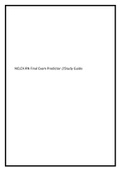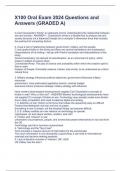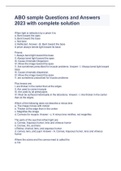Lecture 1: Intro Neuropsychology and the Brain
Early neuropsychology: skull trepanation
● surgical intervention in which a hole is drilled or scraped into the human skull.
Classical antiquity
● Edwin Smith papyrus
○ Observation that brain damage could result in symptoms in other parts of the
body
■ 48 cases studies from the military battle field
● Hippocrates
○ Described man who lost his memory for letters
○ Observed that skull trauma often coincided with hemiparesis on the other side of
the body
~ Hemiparesis: weakness or paralysis of one side of the body
● Plato
○ Localized different qualities soul in different parts of the brain: first proposal for
one-to-one relationship function and brain location
● Herophilus
○ Localized intelligence in brain ventricles
■ Dominant view until 18th century
● Galen → Surgeon gladiators
○ First lesion studies: Brain receives sensory information and has motor control.
Mechanism through fluid energies from ventricles
● Rene descartes
○ Dualism
○ Pineapple gland “seat of the soul” – Interaction mind and body
Localization
● Since 1800s gradually the idea develops that mental functions are localized in specific
parts of the brain ~ cerebral location
○ Location vs Holism
Phrenology: the detailed study of the shape and size of the cranium as a supposed indication
of character and mental abilities.
● Franz joseph gall
From phrenology to localization
● Different function qualities do not result in bulges skull
○ But localization function in the brain?
Localization and lateralization
● Broca's aphasia
○ Tan
○ Language production
● Wernicke's aphasia
○ Language comprehension
Homunculus: But in neuroanatomy, the cortical homunculus represents either the motor or the
sensory distribution along the cerebral cortex of the brain.
,Penfield procedure: Penfield developed a new surgical approach that became known as the
“Montreal Procedure”. He developed his method while his patients were awake and able to
interact with him. Using local anesthetics, he removed the skull cap to expose the brain tissue of
the conscious patient.
Snapshot
● Patient AR: underwent a hemispherectomy at 17 yrs because of severe epilepsy due to
a brain infection
● At 27, he showed some retention and partial recovery of motor and speech functions
~ why can individuals retain or show recovery of functions, after damage to or removal of parts
of the brain?
● Plasticity: the brain can compensate for the loss of certain structures (involvement of
other structures)
● Hierarchical organization of the brain: some functions are regulated (up to a certain
point) by lower levels of the CNS
~the book groups CNS levels in a simplified scheme with different functions
● Spinal cord
● Brainstem
● Forebrain
→ “The higher the level, the higher the function” - but lower levels are necessary
to mediate the function
Random questions
● What is the main function of the spinal cord neural circuits*
○ Simple reflexes in limbs and torso; extension and flexion → different sensory
fibers mediate different reflexes
■ Also rhythmic walking movements
● Can we make inferences about the location of spinal cord damage by looking at a
patient's symptoms
○ Spinal cord segments correspond to regions of the body; dermatomes
○ Bell Magendie (law?): The principle referring to the separation of sensory and
motor neurons of the spinal cord, where the dorsal (posterior) spinal roots are
sensory and the ventral (anterior) spinal roots are motor, thereby implicating that
impulses are relayed in one direction
● Which CNS levels are considered to be the main regions of the brainstem?
○ Hindbrain (myelencephalon + metencephalon)
○ Midbrain (mesencephalon)
○ (Diencephalon)
● What are the primary functions of the following structures of the hindbrain?
○ Cerebellum: motor coordination and motor learning → posture and postural
reflexes, balance, skilled motor activity
○ Reticular formation: ascending system → arousal “activating system”
○ Medulla: vital functions (breathing, cardiovascular)
, ○ Pons: bridges input from and to the forebrain
Traditional view: emotion
● Actually: self-regulatory behaviors, including emotion, (emotional) episodic memory,
spatial behavior, social behavior.
Contemporary view: not a “lobe”, but a circuit also connected to cortical regions.
The basal ganglia
● Several different functions related to - a.o - movement and learning
○ Control/intensity of voluntary movement (not production)
○ Integrating simple movements into patterns and adjusting them to the
environment.
○ Simple learning processes (associative learning)
Huntington's disease: progressive dysfunction and death of cells of the Basal Ganglia
● Hyperkinetic syndrome; primary feature = excessive movement
● Associated with a “hyperactive” dopamine (DA) system
○ Clusters:
■ Movement: excessive, involuntary movement. Eventually leaving the
patient unable to care for themselves
■ Cognitive: attention, memory, “executive function”, dementia in later
stages.
■ Mood and personality: personality changes, paranoia, psychosis,
depression, mania
Crossed brain
● Each hemisphere of brain typically receives input from and sends output to the
contralateral side of the body
● In the visual system, the information from both eyes is combined to represent the left
visual field in the rights occipital lobe of the brain and the right visual field in the left
occipital lobe
A Hierarchy of Function (Chapter 10)
● Patients can have large amounts of brain tissues removed without adversely affecting
behavior
● Behavior can be influence at multiple levels, from the spinal cord to the brainstem to
subcortical structures to the cortex
● In general, lower levels control basic movements or behaviors while higher levels
provide greater precision and flexibility
● Plasticity means the brain can change based on experience or injury
● Subcortical structures can control complex behaviors, but the cortex is important for
initiating and combining these behaviors
Organization of the CNS
● Reflexes
- Responds to appropriate sensory stimulation by stretching, withdrawal, support,
scratching, paw shaking, etc.
, ● Postural support
- Performs units of movement (e.g. hissing, biting, growling, chewing, lapping,
licking) when stimulated, shows exaggerated standing, postural reflexes, and
elements of sleepwalking behavior
● Spontaneous movement
- Responds to simple visual and auditory stimulation, performs automatic
behaviors such as grooming, and when stimulated performs subsets of voluntary
movements (e.g. standing, walking, turning, jumping, climbing)
● Affect and motivation
- Voluntary movements occur spontaneously and excessively but are aimless,
shows well-integrated but poorly directed affective behavior, thermoregulates
effectively)
● Self-maintenance
- Links voluntary movements and automatic movements sufficiently well for
self-maintenance (eating, drinking) in a simple environment
● Control and intention ← most important maybe?
- Performs sequences of voluntary movements in organized patterns, responds to
patterns of sensory stimulation
- Contains circuits for forming cognitive maps and for responding to the
relationship between objects, events, and things
- Adds emotional value
→ Anencephaly is one condition that illustrates the hierarchical organization of CNS function
● Infection with the Zike virus in pregnant women can reportedly lead to insufficient
development of parts/levels of the brain of a fetus
Principles of cortical functions
Maps of the brain
● Based on different factors (e.g. cell structure or time of myelination)
○ Brodmann's cytoarchitectonic map - influential
■ Use of MRI and newer strains have expanded the detail of the maps from
about 50 areas in Brodmann's map up to about 200 today
The forebrain - Neocortex
● Projection maps of the cortex:
Early neuropsychology: skull trepanation
● surgical intervention in which a hole is drilled or scraped into the human skull.
Classical antiquity
● Edwin Smith papyrus
○ Observation that brain damage could result in symptoms in other parts of the
body
■ 48 cases studies from the military battle field
● Hippocrates
○ Described man who lost his memory for letters
○ Observed that skull trauma often coincided with hemiparesis on the other side of
the body
~ Hemiparesis: weakness or paralysis of one side of the body
● Plato
○ Localized different qualities soul in different parts of the brain: first proposal for
one-to-one relationship function and brain location
● Herophilus
○ Localized intelligence in brain ventricles
■ Dominant view until 18th century
● Galen → Surgeon gladiators
○ First lesion studies: Brain receives sensory information and has motor control.
Mechanism through fluid energies from ventricles
● Rene descartes
○ Dualism
○ Pineapple gland “seat of the soul” – Interaction mind and body
Localization
● Since 1800s gradually the idea develops that mental functions are localized in specific
parts of the brain ~ cerebral location
○ Location vs Holism
Phrenology: the detailed study of the shape and size of the cranium as a supposed indication
of character and mental abilities.
● Franz joseph gall
From phrenology to localization
● Different function qualities do not result in bulges skull
○ But localization function in the brain?
Localization and lateralization
● Broca's aphasia
○ Tan
○ Language production
● Wernicke's aphasia
○ Language comprehension
Homunculus: But in neuroanatomy, the cortical homunculus represents either the motor or the
sensory distribution along the cerebral cortex of the brain.
,Penfield procedure: Penfield developed a new surgical approach that became known as the
“Montreal Procedure”. He developed his method while his patients were awake and able to
interact with him. Using local anesthetics, he removed the skull cap to expose the brain tissue of
the conscious patient.
Snapshot
● Patient AR: underwent a hemispherectomy at 17 yrs because of severe epilepsy due to
a brain infection
● At 27, he showed some retention and partial recovery of motor and speech functions
~ why can individuals retain or show recovery of functions, after damage to or removal of parts
of the brain?
● Plasticity: the brain can compensate for the loss of certain structures (involvement of
other structures)
● Hierarchical organization of the brain: some functions are regulated (up to a certain
point) by lower levels of the CNS
~the book groups CNS levels in a simplified scheme with different functions
● Spinal cord
● Brainstem
● Forebrain
→ “The higher the level, the higher the function” - but lower levels are necessary
to mediate the function
Random questions
● What is the main function of the spinal cord neural circuits*
○ Simple reflexes in limbs and torso; extension and flexion → different sensory
fibers mediate different reflexes
■ Also rhythmic walking movements
● Can we make inferences about the location of spinal cord damage by looking at a
patient's symptoms
○ Spinal cord segments correspond to regions of the body; dermatomes
○ Bell Magendie (law?): The principle referring to the separation of sensory and
motor neurons of the spinal cord, where the dorsal (posterior) spinal roots are
sensory and the ventral (anterior) spinal roots are motor, thereby implicating that
impulses are relayed in one direction
● Which CNS levels are considered to be the main regions of the brainstem?
○ Hindbrain (myelencephalon + metencephalon)
○ Midbrain (mesencephalon)
○ (Diencephalon)
● What are the primary functions of the following structures of the hindbrain?
○ Cerebellum: motor coordination and motor learning → posture and postural
reflexes, balance, skilled motor activity
○ Reticular formation: ascending system → arousal “activating system”
○ Medulla: vital functions (breathing, cardiovascular)
, ○ Pons: bridges input from and to the forebrain
Traditional view: emotion
● Actually: self-regulatory behaviors, including emotion, (emotional) episodic memory,
spatial behavior, social behavior.
Contemporary view: not a “lobe”, but a circuit also connected to cortical regions.
The basal ganglia
● Several different functions related to - a.o - movement and learning
○ Control/intensity of voluntary movement (not production)
○ Integrating simple movements into patterns and adjusting them to the
environment.
○ Simple learning processes (associative learning)
Huntington's disease: progressive dysfunction and death of cells of the Basal Ganglia
● Hyperkinetic syndrome; primary feature = excessive movement
● Associated with a “hyperactive” dopamine (DA) system
○ Clusters:
■ Movement: excessive, involuntary movement. Eventually leaving the
patient unable to care for themselves
■ Cognitive: attention, memory, “executive function”, dementia in later
stages.
■ Mood and personality: personality changes, paranoia, psychosis,
depression, mania
Crossed brain
● Each hemisphere of brain typically receives input from and sends output to the
contralateral side of the body
● In the visual system, the information from both eyes is combined to represent the left
visual field in the rights occipital lobe of the brain and the right visual field in the left
occipital lobe
A Hierarchy of Function (Chapter 10)
● Patients can have large amounts of brain tissues removed without adversely affecting
behavior
● Behavior can be influence at multiple levels, from the spinal cord to the brainstem to
subcortical structures to the cortex
● In general, lower levels control basic movements or behaviors while higher levels
provide greater precision and flexibility
● Plasticity means the brain can change based on experience or injury
● Subcortical structures can control complex behaviors, but the cortex is important for
initiating and combining these behaviors
Organization of the CNS
● Reflexes
- Responds to appropriate sensory stimulation by stretching, withdrawal, support,
scratching, paw shaking, etc.
, ● Postural support
- Performs units of movement (e.g. hissing, biting, growling, chewing, lapping,
licking) when stimulated, shows exaggerated standing, postural reflexes, and
elements of sleepwalking behavior
● Spontaneous movement
- Responds to simple visual and auditory stimulation, performs automatic
behaviors such as grooming, and when stimulated performs subsets of voluntary
movements (e.g. standing, walking, turning, jumping, climbing)
● Affect and motivation
- Voluntary movements occur spontaneously and excessively but are aimless,
shows well-integrated but poorly directed affective behavior, thermoregulates
effectively)
● Self-maintenance
- Links voluntary movements and automatic movements sufficiently well for
self-maintenance (eating, drinking) in a simple environment
● Control and intention ← most important maybe?
- Performs sequences of voluntary movements in organized patterns, responds to
patterns of sensory stimulation
- Contains circuits for forming cognitive maps and for responding to the
relationship between objects, events, and things
- Adds emotional value
→ Anencephaly is one condition that illustrates the hierarchical organization of CNS function
● Infection with the Zike virus in pregnant women can reportedly lead to insufficient
development of parts/levels of the brain of a fetus
Principles of cortical functions
Maps of the brain
● Based on different factors (e.g. cell structure or time of myelination)
○ Brodmann's cytoarchitectonic map - influential
■ Use of MRI and newer strains have expanded the detail of the maps from
about 50 areas in Brodmann's map up to about 200 today
The forebrain - Neocortex
● Projection maps of the cortex:


